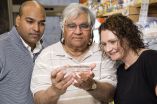(Press-News.org) Researchers at the University of California, San Diego School of Medicine have identified a gene variant that may be used to predict people most likely to respond to an investigational therapy under development for Alzheimer's disease (AD). The study, published March 12 in Cell Stem Cell, is based on experiments with cultured neurons derived from adult stem cells.
"Our results suggest that certain gene variants allow us to reduce the amount of beta amyloid produced by neurons," said senior author Lawrence Goldstein, PhD, director of UC San Diego Sanford Stem Cell Clinical Center and UC San Diego Stem Cell Program. "This is potentially significant for slowing the progression of Alzheimer's disease." AD is the most common cause of dementia in the United States, afflicting one in nine people age 65 and older.
The genetic risk factor investigated are variants of the SORL1 gene. The gene codes for a protein that affects the processing and subsequent accumulation of beta amyloid peptides, small bits of sticky protein that build up in the spaces between neurons. These plaques are linked to neuronal death and related dementia.
Previous studies have shown that certain variants of the SORL1 gene confer some protection from AD, while other variants are associated with about a 30 percent higher likelihood of developing the disease. Approximately one-third of the U.S. adult population is believed to carry the non-protective gene variants.
The study's primary finding is that variants in the SORL1 gene may also be associated with how neurons respond to a natural compound in the brain that normally acts to protect nerve cell health. The protective compound, called BDNF, short for brain-derived neurotrophic factor, is currently being investigated as a potential therapy for a number of neurological diseases, including AD, because of its role in promoting neuronal survival.
For the study, UC San Diego researchers took skin cells from 13 people, seven of whom had AD and six of whom were healthy control subjects, and reprogrammed the skin cells into stem cells. These stem cells were coaxed to differentiate into neurons, and the neurons were cultured and then treated with BDNF.
The experiments revealed that neurons that carried disease-protective SORL1 variants responded to the therapy by reducing their baseline rate of beta amyloid peptide production by, on average, 20 percent. In contrast, the neurons carrying the risk variants of the gene, showed no change in baseline beta amyloid production.
"BDNF is found in everyone's brain," said first author Jessica Young, PhD, a postdoctoral fellow in the Goldstein laboratory. "What we found is that if you add more BDNF to neurons that carry a genetic risk factor for the disease, the neurons don't respond. Those with the protective genetic profile do."
"The value of this kind of stem cell study is that it lets us probe the uniquely human aspects of disease and identify how a person's DNA might determine their drug response, in this case to a potential treatment for Alzheimer's," Young said. "Future clinical trials on BDNF should consider stratifying patients based on their SORL1 risk factor and likelihood of benefiting from the therapy."
INFORMATION:
Co-authors include Jonathan Boulanger-Weill, Daniel A. Williams, Grace Woodruff, Floyd Buen, Arra C. Revilla, Cheryl Herrera, Mason A. Israel, Shauna H. Yuan, and Steven D. Edland, all at UC San Diego.
Funding for the study was provided, in part, by the California Institute of Regenerative Medicine, A.P. Gianinni Foundation for Medical Research, BrightFocus Foundation and the National Institutes of Health (grant 2P50AG005131-31).
CORVALLIS, Ore. - In the continuing debate over how much vitamin E is enough, a new study has found that high levels of blood lipids such as cholesterol and triglycerides can keep this essential micronutrient tied up in the blood stream, and prevent vitamin E from reaching the tissues that need it.
The research, just published in the American Journal of Clinical Nutrition, also suggested that measuring only blood levels may offer a distorted picture of whether or not a person has adequate amounts of this vitamin, and that past methods of estimating tissue levels are flawed.
The ...
Social media has become an important way for institutions to communicate - both sending messages and receiving feedback - with clients and with the general public. Hospitals and other health care organizations use social media for a variety of purposes, but there has been little investigation of whether hospitals ratings that patients and other consumers submit via social media accurately reflect patient satisfaction or the quality of care delivered. A new study published online in the Journal of General Internal Medicine finds a correlation between how hospitals are rated ...
San Antonio -- March 12, 2015 -- NASA's Cassini spacecraft has measured a curious abundance of methane spewing into the atmosphere of Saturn's icy moon Enceladus. A team of American and French scientists published findings in Geophysical Research Letters suggesting two scenarios that could explain the methane abundance observed in the plumes.
In 2005 Cassini's magnetometer and imaging data revealed the surprising existence of geysers in the south polar region ejecting water vapor into space. Scientists now believe that Enceladus harbors an internal liquid-water ocean ...
Many of us are walking around all the time in a fog caused by "social jetlag." That's what happens when we lose sleep because our daily schedules don't match our bodies' natural rhythms. The condition can be a particular problem for shift workers, who work into the night or on a shifting schedule. Now, researchers report in the Cell Press journal Current Biology on March 12 that sleep and workers' general wellbeing could be improved if work schedules took workers' biological clocks into account.
"A 'simple' re-organization of shifts according to chronotype allowed workers ...
This news release is available in German.
Potsdam-Rehbruecke, Germany (March 12th 2015) -- A team of researchers from the German Institute of Human Nutrition in Potsdam and the Charité University Hospital in Berlin have revealed how taste is encoded in patterns of neural activity in the human brain. Kathrin Ohla, the lead researcher on the team, said: "The ability to taste is crucial for food choice and the formation of food preferences. Impairments in taste perception or hedonic experience of taste can cause deviant eating behavior, and may lead to mal- or supernutrition. ...
Light can be used to activate normal, non-genetically modified neurons through the use of targeted gold nanoparticles, report scientists from the University of Chicago and the University of Illinois at Chicago. The new technique, described in the journal Neuron on March 12, represents a significant technological advance with potential advantages over current optogenetic methods, including possible use in the development of therapeutics toward diseases such as macular degeneration.
"This is effectively optogenetics without genetics," said study senior author Francisco ...
Many animals, including humans, acquired essential 'foreign' genes from microorganisms co-habiting their environment in ancient times, according to research published in the open access journal Genome Biology. The study challenges conventional views that animal evolution relies solely on genes passed down through ancestral lines, suggesting that, at least in some lineages, the process is still ongoing.
The transfer of genes between organisms living in the same environment is known as horizontal gene transfer (HGT). It is well known in single-celled organisms and thought ...
Findings from a new study that set out to investigate the evolution of immune defences could boost the development of industrial bacteria that are immune to specific viral infections. The study is published today in the journal Current Biology.
Bacteria have many industrial uses including the production of cheese and yoghurt, paper making, biogas and the synthetic production of hormones like insulin. Viral infections of these bacterial cultures can halt production processes resulting in significant financial cost.
Dr Edze Westra from the Environment and Sustainability ...
LA JOLLA--For infants with severe combined immunodeficiency (SCID), something as simple as a common cold or ear infection can be fatal. Born with an incomplete immune system, kids who have SCID--also known as "bubble boy" or "bubble baby" disease--can't fight off even the mildest of germs. They often have to live in sterile, isolated environments to avoid infections and, even then, most patients don't live past a year or two. This happens because stem cells in SCID patients' bone marrow have a genetic mutation that prevents them from developing critical immune cells, called ...
In a new study, published in Cell Reports, researchers at Uppsala University describe a novel mechanism by which lymphatic vessels form during embryonic development. The finding may open new possibilities for repairing damaged lymphatic vessels using stem cells.
Olof Rudbeck, professor of medicine at Uppsala University, discovered the lymphatic vascular system in the 17th century. A research group at the institute bearing his name, the Rudbeck Laboratory at Uppsala University, has now discovered a novel origin of the lymphatic system.
The prevailing textbook knowledge ...

